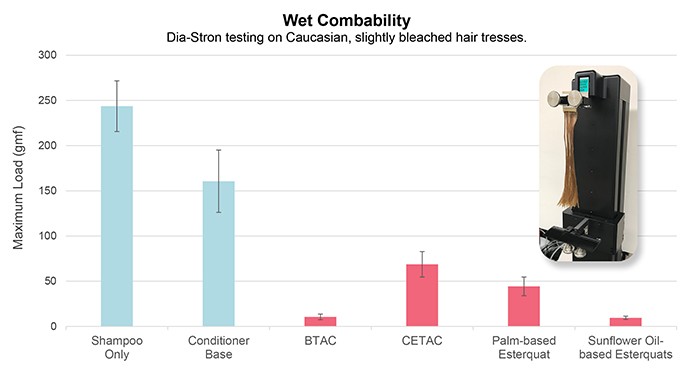Advancing Hair Conditioning
Today's consumers want more from their hair conditioners. Stepan's novel esterquats for hair conditioning were developed to fulfill their performance requirements and demand for readily biodegradable and lower toxicity ingredients.
Giving Consumers What They Want: Great Hair, Reduced Environmental Impact
Many people rely on hair conditioning products to improve the look, feel and manageability of their hair. While the performance of these products is a must for demanding consumers, in the last few years, consumers have clamored for more sustainable products. Stepan Company recognized this need and hit the drawing board to develop a solution for this growing market.
The most common cationic hair conditioning agents used today are behentrimonium chloride (BTAC) and cetrimonium chloride (CETAC). BTAC is the industry standard for conditioning performance and is considered a better quaternary for combing and achieving a soft feel. Due to their potential to cause irritation, more regions are adopting use-level restrictions for BTAC and CETAC. These products are also dangerous to aquatic life. Both products have environmental impacts that concern environmentally focused consumers.
Esterquats, on the other hand, are known to be readily biodegradable, mild and less toxic to aquatic life. For decades, this chemical class of cationic agents has been used as fabric softening ingredients, but many of them are animal-derived. That has become unattractive in the personal care market. And although vegetable-derived esterquats are available in the fabric softeners market, these products do not provide the same premium conditioning performance on hair as BTAC.
With these challenges in mind, Stepan’s Personal Care team set out to develop a hair conditioning agent that provides performance and reduces impact on the environment. Stepan began working on a cationic hair conditioning agent that could provide the positive environmental and safety profile of esterquats, along with the combing and conditioning performance of BTAC.
Stepan’s product development started with sunflower seed oil, a non-GMO, plant-based raw material grown abundantly in North America and Europe. Plant-based esterquats currently on the market are traditionally based on palm oil, but the palm oil carbon chain length is not optimal for hair conditioning. Sunflower oil contains primarily C18 fatty chain moieties and has a high degree of unsaturation, which is believed to assist in coating and lubricating the hair for ease of combing.
Stepan’s Personal Care team in North America decided to use a chloride-based quaternizing agent, making it sulfate-free – another claim increasingly important to consumers, especially in the Americas. The resulting product, STEPANQUAT® Helia, is free of water and is comprised of 95% total cationic and emollient actives. This sunflower oil-based esterquat is considered Derived Natural by ISO 16128 [Standard], and has been tested for irritation potential using Human Repeat Insult Patch Test (HRIPT) methodology and was found to be non-irritating, hypoallergenic and mild to the skin.
Closely following the development work already completed in North America, Stepan’s Personal Care team in Europe took a slightly different approach and was able to create a molecule that is China IECSC-listed. In combination with pending REACh registration, the resulting product, STEPANQUAT Soleil, is the global-friendly addition to Stepan’s naturally derived conditioner portfolio. STEPANQUAT Soleil is also a sunflower oil-based esterquat that is free of water and solvent, and comprises 100% total actives. This sunflower oil-based esterquat is considered Derived Natural by ISO 16128 [Standard], and the Natural Origin Index for the product is 0.88.
While these two esterquats were designed to meet as many sustainability criteria as possible, another crucial aspect to assess is the technical performance. The graph below shows the result of a combability test using a Dia-Stron instrument that measures the force it takes to pull a comb through a standardized tress of wet hair. To simulate damaged hair, the tress tested is bleached Caucasian hair. The greater the force, the poorer the conditioning performance.
The first bar is shampooed and rinsed hair, unconditioned. The second bar is the base conditioning formulation, without the cationic conditioning agent. Present in the base are fatty alcohols and cellulose thickening agents typically used in hair conditioners to provide viscosity and formulation stability. When 2% active conditioning agent is added to the base, the force needed to comb through hair is significantly reduced by the cationic conditioning agents. CETAC and palm-based esterquats are not premium performers. Only the esterquats based on sunflower oil were able to equal the performance of the leading chemistry, BTAC.

Today's consumers want more from their hair conditioners. Stepan's novel esterquats for hair conditioning – STEPANQUAT® Helia and STEPANQUAT Soleil – were developed to fulfill their performance requirements, and their demand for readily biodegradable and lower toxicity ingredients.
Learn more about the benefits STEPANQUAT Helia and STEPANQUAT Soleil can bring to your formulations.
Interested in reading more about Stepan’s latest trail blazing innovations?



